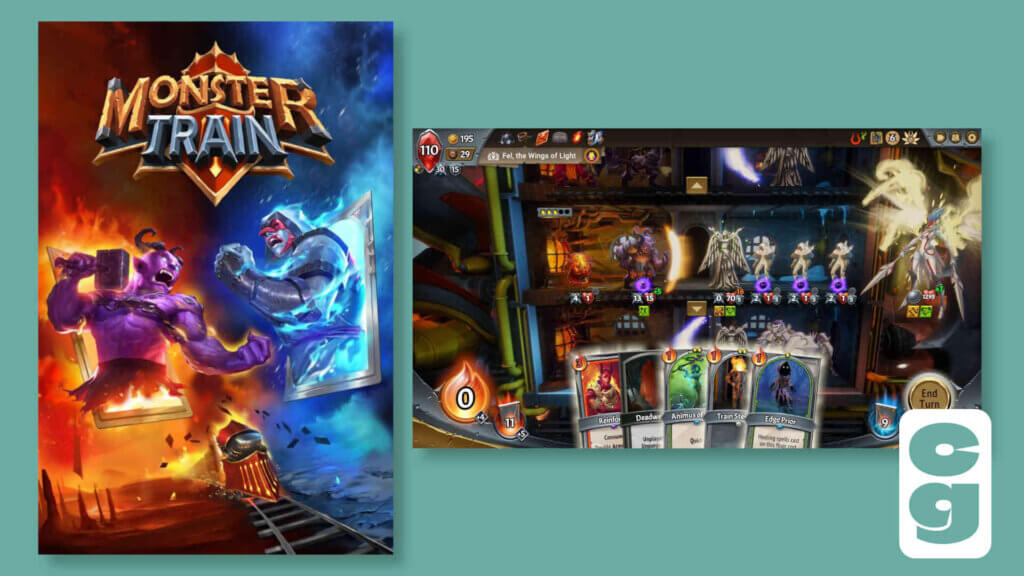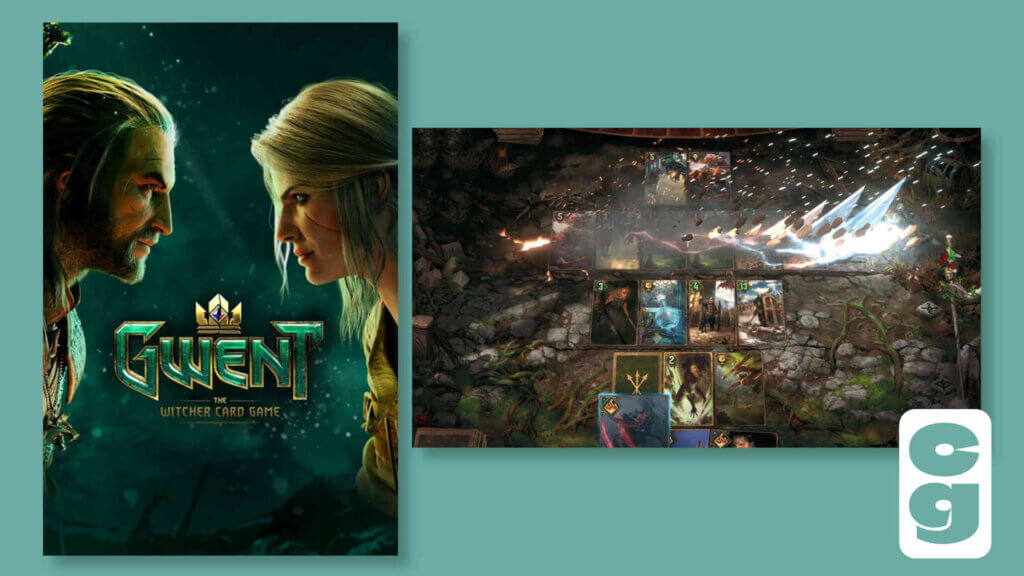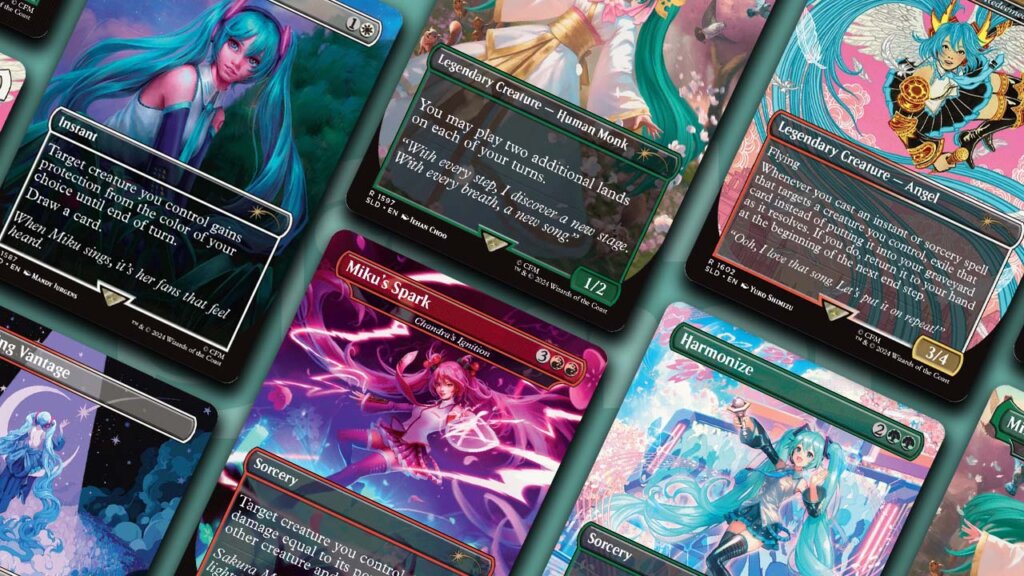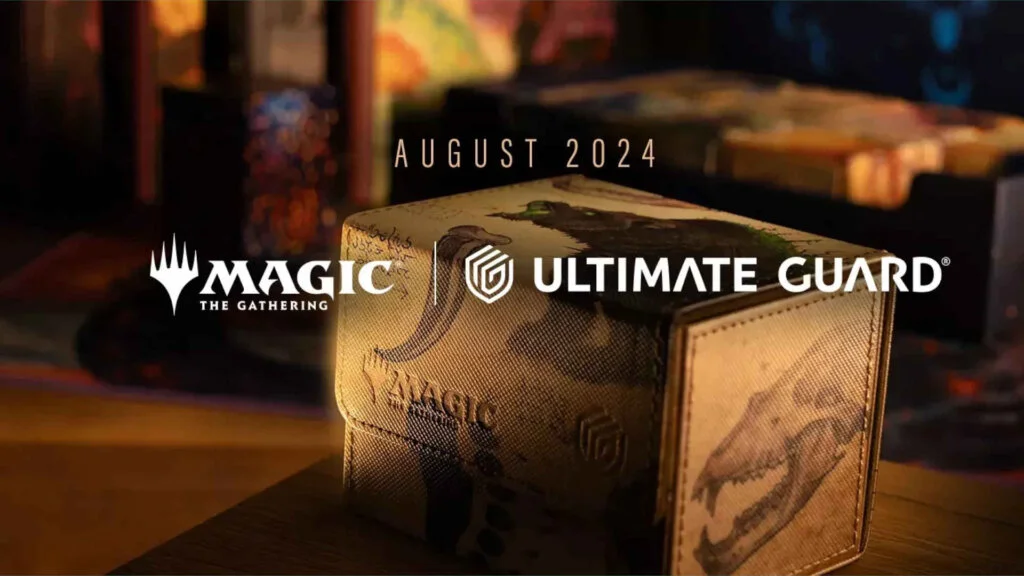One of the joys of playing card games is being able to compete against opponents on the tabletop; as well as that, collecting physical cards is also a truly addictive element of the hobby.
Yet sometimes, digital card games can prove just as addictive as the real thing.
They can also add elements that are difficult or prohibitive to pull off with physical cards – or add audiovisual touches that are impossible to replicate with real world card games.
There are hundreds of card games available in digital form on Steam – and, as a big fan of both tabletop and video games, I’ve spent many hours playing an awful lot of them!
Which are the best though?
Let’s take a look – as we check out the best card games on Steam!
Table of Contents
Toggle1. Monster Train (2020)

The results are in, and Monster Train is officially the best Card game on Steam!
Having Monster Train at number one might be a little surprising, but I will die on this hill.
Or rather, I will die on this train. Repeatedly – and I’ll keep going back for more!
Though not as well known as other games on this list – such as Slay the Spire, which you’ll be reading about very soon – Monster Train is, in my humble opinion, incredibly underrated.
It also deserves to reach a much bigger audience. Who knows, perhaps you’ll be inspired to play Monster Train for yourself after reading this list.
So, what is Monster Train, and what makes it so good?
Monster Train has an incredibly unique setting: a train literally from Hell, being pursued by the various denizens of Heaven – with you doing your best to keep the last flame of the underworld, the Pyre, burning.
You do this with a deck of cards, featuring characters that you’ll deploy on the various floors of your train; your Pyre sits at the top of the locomotive’s levels, with Heaven’s warriors entering at the bottom and your forces trying to slow or stop their ascent – before they can reach and destroy the Pyre.
Should you survive a round, you get to take a breather and get yourself various upgrades – permanent and passive in the form of Artifacts, extra cards to build into your deck or even special upgrades to make existing cards in your deck more powerful.
There’s a range of demonic factions to choose from; as you always choose two to head onto the tracks with, you’ll soon learn the strengths and benefits of each faction’s available characters and cards, as well as which factions complement each other in a way that best fits your play style.
Being a card-based roguelike, it’s naturally pretty challenging to make progress in Monster Train. Still, you’ll gradually get better and better, experimenting with factions and card combos that work just the way you need them to; it’s a hugely impressive and densely layered game.
It’s also absolutely gorgeous, with stunning art design and some phenomenal creatures, with allies and enemies alike being beautifully illustrated, though with fairly minimal animation.
Overall, Monster Train easily takes the top spot of the best card games on Steam for me.
So, let’s take a look at what’s next!
2. Slay the Spire (2017)

Perhaps no other game has been as influential to the card-based roguelike genre as Slay the Spire.
It’s a brilliantly minimalist game; marrying accessible card game mechanics with the typically challenging roguelike structure, it’s also genuinely addictive too.
In Slay the Spire, players begin by choosing a character – each of which has differing stats and a unique set of cards, along with the ability to collect cards specific to that character during their run.
During the game, players work their way through the levels of the titular spire – with each branching path offering various types of encounter, along with a boss at the end of the level.
The types of encounter can be enemy-based – leading to combat – or lead to healing, buying new items and equipment or upgrading cards.
Cards are used in combat, with enemy actions telegraphed using a symbol above their head – helping you to plan your turn with the cards in your hand.
It’s a deceptively simple, yet nicely layered game that’s incredibly easy to pick up and learn – yet difficult to master.
Being a roguelike, naturally you’ll expect to die frequently – albeit gaining experience and widening the selection of cards available to you on subsequent runs.
Like all of the best roguelike deck building games, it’s incredibly moreish and you’ll often find yourself sitting down for a short session, then still going for just one more run a few hours later!
3. Gwent: The Witcher Card Game (2017)

It’s fair at this point to say that Polish fantasy saga, The Witcher, has become a multimedia phenomenon – even spawning a live action, hugely popular Netflix series.
Though originally brought to life in a 1990 novel – followed by sequels throughout the 90s (and another in 2013) – The Witcher was popularised outside of its native Poland by a series of video games by CD Projekt RED, beginning in 2007.
Thanks to the popularity of the video games, English translations of the novels started to be published from 2007 onwards too.
The third game in the video game series – The Witcher 3: Wild Hunt – was released in 2015, and it included a mini-game called Gwent.
Gwent featured in The Witcher novels and was fleshed out by CD Projekt as an in-game activity for The Witcher 3: Wild Hunt. It proved so popular with players that it was spun off into its own, standalone card game.
Unlike the other games on this list so far, Gwent is intended to be played against other players; it has the feel of a TCG/CCG rather than a roguelike.
In Gwent, players choose one of six factions, then build their decks from cards of their chosen faction, as well as neutral cards.
As in any collectable card game, each faction has its own strengths, strategies and opportunities for combos; it’s generally up to the player to discover which is the best for their preferred style of play.
The goal of Gwent is to win two out of three rounds; to achieve this, players must play cards to gain power points on the board, claiming victory if they have the most points on the board at the end of a round.
Each played card has a certain number of power points and these can be altered by a variety of different card effects. Along with the simplicity of the game, it’s these effects and the possibilities afforded by various card combos – spawning other units, damaging the cards played by your opponent and boosting your own card stats, for example – that give Gwent its appeal.
Though it is set in The Witcher universe and full of nods to the series in its illustrations, Gwent is a game that doesn’t require any knowledge of The Witcher to be enjoyed; instead, it’s a smartly designed, accessible card game experience that just about anyone can pick up and play.
4. Star Realms

Based on a physical card game that is genuinely one of the finest deck building experiences around – we rate it very highly here at Card Gamer – Star Realms is just as addictive in digital form as it is on the tabletop.
Players begin with an identical deck of ten cards; these comprise basic ships that provide attack and trade points – the former used to directly damage opponents and the latter to buy new cards from the central marketplace.
Purchased cards go into your discard pile – and these offer various stronger attack, more valuable trade and even authority values, that allow you to ‘heal’ from being damaged.
When you run out of cards to draw, you shuffle your discard pile to make a new draw deck – thus having access to all of the cards you’ve been buying, giving yourself new and more powerful cards to use.
The object of the game is to whittle your opponent’s authority from 50 to zero points; it’s a hugely addictive game that perhaps looks complicated at first glance, but it’s intuitive and easy to learn.
With four different factions, each with their own specialisations and combo opportunities – with no restrictions on their use by either player, aside from their trade cost – there’s a wide variety of strategies that can be utilised, depending on the options presented by the central marketplace in any given round.
Star Realms is excellent in its digital form too, though its presentation is a bit bare bones – and, unfortunately, the Story mode’s difficulty seems to be dialled up way too high to be enjoyable at times.
That said, it’s still a peerless game in multiplayer mode – and progress, as well as DLC extras, of which there are many (mirroring the expansions of the physical game), carry over between any device you play on too.
5. Magic: The Gathering Arena

Though many readers may balk at the placement of one of the very finest card games of all time – and the original CCG, which continues to spawn legions of imitators and wannabes – there’s nothing quite like playing Magic: The Gathering across a table from an opponent.
However, if that’s not an option for you, then Magic: The Gathering Arena is absolutely the next best thing.
It took a surprisingly long time for Magic: The Gathering (MTG) to get a truly worthy and accessible digital version up and running, with Arena having only been launched as a full release for Windows in 2019 and for Steam in 2023 – 30 years after the original tabletop card game was released in 2023!
Pedants and long time MTG fans would likely point out the existence of Magic: The Gathering Online (MTGO), which has been available since 2002; however, it has a complicated and dated business model, as well as a lack of accessibility in general in its design.
Arena isn’t perfect, however – which is another reason I’ve chosen not to rank it higher on this list.
There’s the problem of Arena’s microtransaction elements and its pay to win structure – though, in fairness, the latter has always been an element of MTG, even in its card form.
Despite this, publisher Wizards of the Coast often give players small numbers of free, in-game booster packs when new sets are released – and codes for free packs are released on a reasonably frequent basis.
The magic (pun most definitely intended) of MTG’s timeless design and ever evolving meta really shines through in MTG Arena; not only that, but having new card sets added as soon as they’re released – as well as older cards being added at a reasonable rate too – also means that you can keep up with the developments in the physical game as you play on Steam too.
Matchmaking can be a bit of a pain – you’ll often come up against incredible decks, featuring cards and combos that you’ll never have anticipated – but again, this is to be expected somewhat, in a game with such depth in the number and scope of cards available.
Cross platform play means you can also carry your game progress and card collection over to mobile devices too.
So despite a few problems, MTG Arena is a great, accessible and pretty comprehensive implementation of one of the best and most popular – and most enduring – card games in the world.
This article may contain affiliate links. If you use these links to purchase an item we may earn a commission. Thank you for your support.




